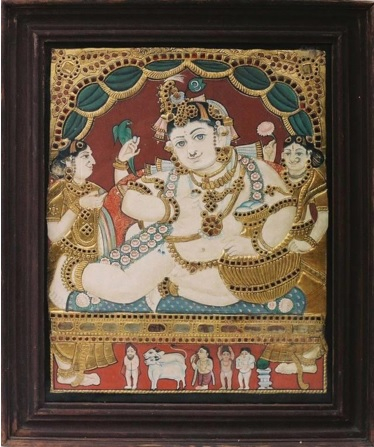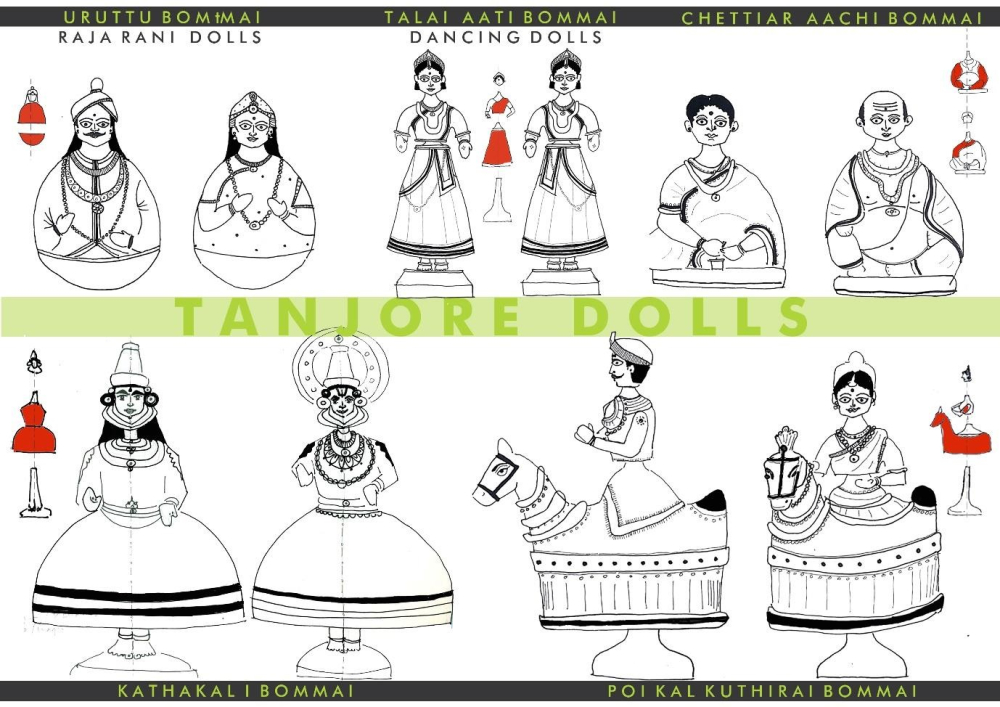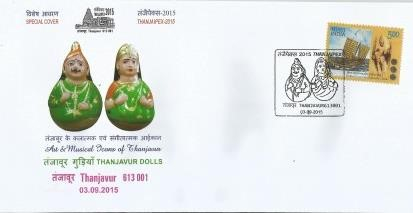Dussehra is celebrated differently in different parts of India. In Tamil Nadu, it is celebrated as Golu or Kolu. In this festival, dolls—brightly coloured and made by rural artisans—are displayed thematically, narrating the legend of Dussehra. People chant shlokas, draw kolams and offer food to gods and goddesses for over nine days.
Analysing the form and structure of golu
There are phenomenal parallels that can be drawn between the order and structure of a golu dispay and the pyramidical gopurams (temple gateway towers) of Dravidian temples (Figs 1 and 2). The golu display is canonically acceptable only when oriented towards certain cardinal directions similar to the planning of the gopurams in temples. Gopurams are archetypally tiered in odd numbers having three, five or seven storeys, whose assembling is relative to the size of the village, town or city it is built in. Correspondingly, golu displays are also tiered wherein the smallest golu consists of three tiers while the grand golu displays might have about eleven or thirteen tiers. It is also relative to the size and volume of the room and the house it is arranged in. With increasing space constraints, the golu sizes are now comparatively smaller with small- and medium-sized dolls.

Fig. 1. Madurai Meenakshi temple's gopuram, Tamil Nadu (Photo Courtesy: Wikimedia Commons)

Fig. 2. A golu display (Photo Courtesy: Prathyusha Ravi)
It is said that the early tradition of golu had steps of diminishing widths resembling the gopuram, the difference being that the golu display can only be viewed upfront. The form of the gopuram constitutes a stepped pyramid diminishing in width, resting on the widest platform that offers a wide 360-degree view. Modern display structures for golu are tiered, but contain treads of equal width much like a staircase. Yet it appears like diminishing tiers when viewed upfront. Modern golu padi (Tamil term for tier) or steps are quite utilitarian, manufactured from steel or wood that serve multiple purposes once the festival is over. This is the structural paradigm of the golu padi with occasional variations such as L-shaped, U-shaped, polygonal, semicircular and circular structures.
Built to narrate scenes from epics and mythologies, both golu displays and gopurams stimulate interest and visual curiosity amongst viewers almost immediately. Both structures methodically frame anthologies and are fiercely symmetrical on multiple levels. The structure of the gopuram is adorned with sculptures and figures while the golu is adorned with dolls (the only difference being the scale!). The size of the figures (both the sculptures and the dolls) is in tandem with the width, height and scale of the structure. Interestingly both the sculptures for the gopuram and the dolls for the golu are crafted by silpis or craftsmen indicating great skill and artistry. The assortment of figures, sculptures and dolls displayed are often made with different techniques and materials.
The ceremonial finial or kalasam (copper pot), arguably the most prominent feature in both the golu and the gopuram, is given the honour of being centrally located in the upper tiers. The kalasam is a handed-down copper pot, which is filled up with water or rice and topped with a coconut. Decorated with mango leaves, jewellery and clothing, it is often the highlight of the display. It is believed that the copper pot is energised with the chanting of shlokas, music and dance and in turn offers positivity and sanctity to both the temple and the golu display.
The marapachi (red sandalwood) dolls, another significant aspect of golu displays, are said to represent the man and the woman of the household and therefore absent in the temple gopuram. The Tridevi—Durga, Lakshmi and Saraswati—occupy a vital position in all golu displays. Dolls come mostly in pairs and are arranged with utmost symmetry, reserving the central axis to solo dolls, while also being arranged hierarchically with respect to anatomy, posture, colour, height and weight of the figures. Typically, larger dolls occupy the upper tiers, mid-sized dolls are placed in the intermediate tiers and smaller dolls occupy the lower tiers since the display is viewed while sitting down. The devotees recite shlokas, sing or play music or dance in front of the display. The entire display occupies the place of pride in the house for nine days of Navaratri and is made open for parade to relatives and friends.
Setting up the golu
Golu displays vary from house to house, based on scale, grandeur, size, and most importantly, the beauty and arrangement of the dolls. Modern golu displays are strategically set on a site (inside homes) that allows easy access, comfortable viewing and gathering of guests, while simultaneously being close to the kitchen and the puja or prayer room on account of the multiple journeys to be made between the three zones during the course of the festival. Further, it is to be oriented east–west and never towards the south. Despite these constraints, it is made sure that the golu site does not drastically affect the mundane functioning of the household.
Once the site is chosen, it is given a ritualistic cleaning. Then, the backdrop is readied with garlands, drapes and paintings, depending on the artistic imagination of the creator and their family. The golu padi can either be built with cartons, boxes, books, or bought from shops. The readymade padis are assembled with nuts and screws. Whether readymade or self-made, the padi is assembled with utmost care so that they are stable enough to carry the load of the dolls for the nine-day festival. Once the padi is set up, it is skilfully wrapped with cotton or silk dhotis/saris, usually white in colour, to make the vibrantly coloured dolls appear dominant. Every day during prayers silver, bronze or clay lamps are positioned in front of the display, to be lit along with incense sticks. The display is categorically regarded inaccessible for two reasons: once assembled the upper tiers are unreachable due to its form; and the second reason being that no part of the display—the structure, fabric or the dolls—may be touched or moved during the period of nine days. The use of artificial flowers for decoration became conventional for the same reasons. Natural flowers adorn the floor along with hand drawn kolams so that they can be easily replaced. Navadhanya (nine auspicious grains) is also grown and nurtured for the festival apart from offering neivedyam (food offered to the gods).
Cultural significance of golu dolls
A singular narrative about the kind of toys deemed divine or believed to represent God is formally absent. Any toy/figurine, given a spot in the golu padi is considered divine, honourable and worshipped for nine days during Navaratri. It is common for children to contribute their toys to the golu padi for Navaratri, during which these toys are glorified and idolized, and after which they go back to being toys that may be played with. For such children, Navarati presents a tough test as they keep seeing their favourite toys on display but are not allowed to touch them. For this reason, the display of golu may be temporarily withheld in households that have very young children and is resumed once they grow up.
Further, it is a cultural norm to add at least one new doll, big or small, to the golu display every year. This helps in sustaining the craft and ensuring an income flow to the craftsmen. Faded and broken idols are generally not displayed in golus, since gods must always be shown to have good health and prosperity. But this rule is not followed too rigidly and may vary depending on the keepers of the golu. Faded dolls may be repainted, broken dolls may be accessorised (usually with garlands, jewellery or fabrics) or mended. However, severely broken, distorted or damaged dolls are never displayed as golu. Restoring golu dolls has recently become a successful commercial activity.
Many older dolls have superior facial features, posture, jewellery and costumes when compared to the state-of-the-art varieties. Therefore, conserving dolls needs more skill and expertise, which often turns out to be more expensive than replacing them. But most keepers of the tradition tend to be sentimental about their handed-down dolls. Being a noteworthy part of a Tamil bride’s trousseau, they are eventually added to her family’s collection for golu display. The marapachi dolls are usually given to toddlers, along with the first set of toys. While licking and chewing the dolls, sculpted from red sandalwood, the toddler is said to benefit from its medicinal properties, which help build immunity and aid digestion. Therefore, this particular craft is valued by people, making them protective about their dolls and safeguarding them as tokens from the past. Every night during the festival, lullabies are sung to put the gods to sleep and on the eve of the tenth day all the dolls are laid to rest from their otherwise standing position. On the eleventh day, the dolls are wrapped up carefully with newspapers and cloth and stored till the next Navaratri. It is ensured that they are packed in a manner that would shield them from crushing one another. Sufficient precautions are taken to keep the dolls away from moisture and humid conditions that may possibly damage their sheen, colour or form.
Making of golu dolls
Traditionally, golu figurines were made of natural materials such as wood, clay, terracotta, cloth and plant fibres, and painted with natural dyes and colours. They are made by carving wood or moulding clay with bare hands. The material, craft, technique and appearance depend on locally available materials, geography and craftsmen. Some notable examples of golu dolls are Tanjore dolls from Tamil Nadu, Kondapalli dolls from Andra Pradesh, Chennapattna dolls from Karnataka, clay dolls from West Bengal, etc. Fortunately, these crafts have survived well with constant innovation since golu is still a widely practised festival.
Tanjore golu dolls or Thanjavur Bommai
Tanjore or Thanjavur served as the capital of the Great Chola empire and subsequent ruling dynasties of the Tamil land such as the Pandyas, Vijayanagaras, Madurai Nayakas, Thanjavur Nayaks, and Thanjavur Marathas. It still continues to be a significant hub for art and architecture. It is home to very unique architectural and artistic achievements such as the Great Living Chola temples (World Heritage Sites), Tanjore paintings and Tanjore golu dolls or Thanjavur Bommai (Tamil term for toy/doll). Both these art forms flourished in the patronage of the Nayaka and Maratha rule during formal attempts of rewriting and illustrating sacred texts in which some names of the court painters have also been well recorded.
There are mutual references between the murals on the walls of the palace and Tanjore paintings (Figs 3 and 4), showing royal subjects with taut figures and chubby cheeks, plump chins, almond-shaped eyes, meaty hands and legs. Both male and female representations of the royal family share these facial features and are undoubtedly well dressed in finery. The royal women are draped in saris that have butta or dots and men sport peplum kurta and dhoti and both wear crowns on their head. The expressions of Tanjore murals and paintings have many common visual qualities suggesting that the Tanjore dolls are probable solid interpretations of this two-dimensional art forms.

Fig. 3. A Tanjore painting of Lord Krishna as an infant (Photo Courtesy: Prathyusha Ravi)

Fig. 4. A painting of Raja Serfoji (Photo Courtesy: Wikimedia Commons)

There are two main varieties of Tanjore golu dolls. The urutu bommai also known as the Raja Rani bommai (Fig. 5) are a pair of rocking dolls with hemispherical bases and measure about 10 –15 cm in height. The Raja Rani bommai appears to be amusing but faithful depictions of the Maratha King Serfoji II and his consort.
The talai ati bommai literally translates to a 'nodding doll' whose head and other body parts are pivoted and interlocked with one another and allows it to sway with the slightest external force. There are three to four variations of this kind of doll like the dancing doll such as dolls performing Bharatanatyam, Kathakali, Kuchipudi. There are also dolls called Poi Kal Kuthirai (dancers mounted on dummy horses). All these present the rich cultural background of Tanjore. The famous pair of Chettiar–Aachi dolls are said to represent the merchant community of the Tamil land. These dolls come in all sizes measuring 15–60 cm in height.
The history of the Tanjore dolls is not charted out clearly, but the ancestral doll makers involved in this craft for five generations ascertain that this kind of doll making has sustained for more than a century. Unfortunately, physical evidences of the earlier dolls are not available in the local museums or with the doll makers. This is particular only to the urutu bommai; the talai ati bommais, on the other hand, are said to be 40- to 45-years-old innovations.
In 2009, the urutu bommai dolls were included in the Government of India's GI Registry, a statutory recognition of the toy's geographical origin to this region. Being a prominent feature of the townscape of Tanjore, they can be seen on the entrances of buildings; they form landmarks in roundabouts; and are featured on billboards and signages. In 2015, the Tanjore dolls were introduced as postal stamps (Fig. 6).

Fig. 6. Tanjore dolls as postal stamps (Photo Courtesy: Prathyusha Ravi)
Tanjore dolls are made using two different raw materials. Traditionally made with clay, these dolls are lately being made out of plaster of Paris (POP). It is said that clay dolls may be produced in larger quantities than POP dolls provided there is ample sunshine for drying. Both the dolls require moulds but the moulding processes differ. Although there are not many notable differences in the outcome, subtle differences may be pointed out on close observations. Some of the reasons stated for the change in material were that POP dolls are lighter and easier to store. The oil paints that are used for POP dolls fade lesser with time than their clay counterparts on which water-based paints are used.
The knowledge of the craft is perpetuated in multiple ways—teaching and learning through generations or by apprenticing with practitioners or by attending training centres set up by state and private agencies. Hence, the doll makers may join the community either by birth or by choice, without gender or caste biases. The artisans are the producers of the dolls leaving the aspects of marketing and trading to the merchants. It is not clear as to how the GI tag has helped promote the craft and the craftsmen, beyond establishing a unique identity for the dolls. Battling against the Chinese plastic toy market, Tanjore dolls are quite affordable and sold widely. Street hawkers by the roadside, stalls in tourist places and the emporiums of state handicrafts trade these culturally significant dolls which shows that these dolls are in excessive supply but with inadequate demand. The doll makers seem outwardly unhappy with the lack of patronage and sale of the dolls discouraging their children from pursuing the craft. The fate of the Tanjore dolls is as much in the hands of the buyers as in the hands of the makers.

